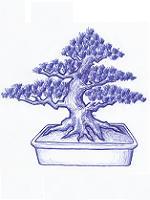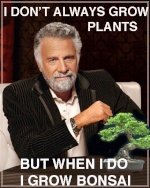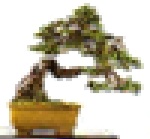Expanded clay aggregate, Hydro pebbles
+7
reg-i
drgonzo
coh
akhater
Billy M. Rhodes
Orion
Bonsai Kas
11 posters
Page 1 of 1
 Expanded clay aggregate, Hydro pebbles
Expanded clay aggregate, Hydro pebbles
Hey guys, and girls 
I've been using expanded clay aggregate/Hydro for my bonsai for the past two years. I mix it 60/40 (Hydro/soil) with non fertilised organic soil and add a few natural fertiliser pellets for the spring growth when I don't feed liquid fertiliser yet. For me it works very well since it retains moisture well since I can't water for more than once a day. Even in the rainy spring and autumn here it stays very open and airy when used like this. When I repot I water it so the top soil seeps in nicely and add a little extra organic soil on the top to prevent evaporating too much water on hot days. It's dirtcheap and doesn't break down at all. It roots very well and I'm always surprised how open the soil stays. It seems the trees really like it because some corns get allmost enveloped with little hair roots like the tree is saying "mine!"
What is your experience with this medium, I hardly see anyone experienced use it here and I'm wondering, why not?

A pic for reference.
Thanks for reading.
I've been using expanded clay aggregate/Hydro for my bonsai for the past two years. I mix it 60/40 (Hydro/soil) with non fertilised organic soil and add a few natural fertiliser pellets for the spring growth when I don't feed liquid fertiliser yet. For me it works very well since it retains moisture well since I can't water for more than once a day. Even in the rainy spring and autumn here it stays very open and airy when used like this. When I repot I water it so the top soil seeps in nicely and add a little extra organic soil on the top to prevent evaporating too much water on hot days. It's dirtcheap and doesn't break down at all. It roots very well and I'm always surprised how open the soil stays. It seems the trees really like it because some corns get allmost enveloped with little hair roots like the tree is saying "mine!"
What is your experience with this medium, I hardly see anyone experienced use it here and I'm wondering, why not?

A pic for reference.
Thanks for reading.

Bonsai Kas- Member
 Re: Expanded clay aggregate, Hydro pebbles
Re: Expanded clay aggregate, Hydro pebbles
Is that the same stuff that goes by the name "Aqua soil"? It's a substrate used in aquariums.

Orion- Member
 Re: Expanded clay aggregate, Hydro pebbles
Re: Expanded clay aggregate, Hydro pebbles
I use Turface which is also a clay product but much more irregular in shape. I have not seen this product available recently. I have seen a similar product used for Orchid culture.

Billy M. Rhodes- Member
 Re: Expanded clay aggregate, Hydro pebbles
Re: Expanded clay aggregate, Hydro pebbles
been using the same for 3 years 60 to 70 % of clay balls and 30 - 40% of sieved peatmoss simply because where I live there is no bonsai soil that is usually used
i water once a day no more and fertilize pretty heavily NPK 20-20-20 twice a week at full dose. No issues so far
i water once a day no more and fertilize pretty heavily NPK 20-20-20 twice a week at full dose. No issues so far
akhater- Member
 Re: Expanded clay aggregate, Hydro pebbles
Re: Expanded clay aggregate, Hydro pebbles
It looks like a product called hydroton (google it for more info), which I've seen in some hydroponic shops. I'm pretty sure it came up in a discussion not too long ago, and at least one member was using it. Can't remember who, though.
Edit to add - found the thread: thread on dyna-rok , the product referred to is called dyna-rok and appears to be very similar
Edit to add - found the thread: thread on dyna-rok , the product referred to is called dyna-rok and appears to be very similar

coh- Member
 Re: Expanded clay aggregate, Hydro pebbles
Re: Expanded clay aggregate, Hydro pebbles
Based upon their web site dyna-rok is a diatnaeous (sp) earth product and not clay. Diatnaeous (sp) earth comes from the remains of ancient sea animals and is almost pure silica; it is frequently used as a filter material in pools and as an organic pesticide, it sharp edges puncture the exoskeleton. Inhaling the product can be VERY dangerous.

Billy M. Rhodes- Member
 Re: Expanded clay aggregate, Hydro pebbles
Re: Expanded clay aggregate, Hydro pebbles
Near as I can tell the product advertised is now called Dyna-Rok II. They mention in the brief web site description that it is made from sedimentary rock consisting of fossilized diatoms, colloquially this is known as diatomaceous earth.
Turface is made from either Montmorillonite or Attapulgite, these are both smectite clays and are high fired to produce the product Profile LLC. has named Turface. Technically the resulting mineral after the calcination is called arcillite. However, neither of these clays are considered diatomaceous earth.
So there is a basic difference in the two products. Dyna also doesn't mention whether their Dyna-rok is calcined.
Apart from the geological difference, aesthetically, I don't care for the "little round balls" look in the soil, it looks unnatural to me.
-Jay
Turface is made from either Montmorillonite or Attapulgite, these are both smectite clays and are high fired to produce the product Profile LLC. has named Turface. Technically the resulting mineral after the calcination is called arcillite. However, neither of these clays are considered diatomaceous earth.
So there is a basic difference in the two products. Dyna also doesn't mention whether their Dyna-rok is calcined.
Apart from the geological difference, aesthetically, I don't care for the "little round balls" look in the soil, it looks unnatural to me.
-Jay

drgonzo- Member
 Re: Expanded clay aggregate, Hydro pebbles
Re: Expanded clay aggregate, Hydro pebbles
Thanks for the clarification - I didn't have time to look up the details earlier. Dyna-rok is in fact made from diatomaceous earth, while hydroton appears to be a calcined clay product very similar to the one being discussed here. One of the IBC members (Mike Page) apparently uses the dyna-rok as his primary growing media, so maybe he can comment further on his experience with it. I know people use the other diatomaceous earth product ("floor dry" from NAPA) successfully, so I would imagine either dyna-rok or hydroton could be suitable substrates, if used properly.

coh- Member
 Re: Expanded clay aggregate, Hydro pebbles
Re: Expanded clay aggregate, Hydro pebbles
Floor-dri from Napa, and Oil-dri and Hi-dri are usually fullers earth. Although I have seen absorbents made with diatomaceous earth however the granule size was very small. Montmorillonite and Attapulgite are themselves referred to as "fullers Earth."
At any rate, a quick zip around at prices online for Dyna-rok II would seem to place it at roughly twice the price of Turface.
-Jay
At any rate, a quick zip around at prices online for Dyna-rok II would seem to place it at roughly twice the price of Turface.
-Jay

drgonzo- Member
 Re: Expanded clay aggregate, Hydro pebbles
Re: Expanded clay aggregate, Hydro pebbles
Jay, the NAPA "floor dry" (#8822) is listed on the package as calcined DE. I picked up a bag for testing recently. It is similar to turface in particle size, but the color (when dry) is whiter. The floor dry is slightly softer than turface - I can break many of the particles with my fingernail (though not easily), whereas most of the turface particles are too hard to break that way.
So far, the floor dry has held up quite well to prolonged soaking and also repeated freeze cycles - little to no loss of particle integrity, no mush. This is quite the contrast to all the other "turface substitutes" I've tested ("special kitty", "oil dri" from WalMart) which quickly break down.
I don't see any reason to switch from turface, but if one cannot find turface locally, the NAPA floor dry looks to be a very viable substitute.
I have no experience with the dyna-rok and the hydroton but they also appear to be suitable for those who cannot find turface or other cheaper substrates.
So far, the floor dry has held up quite well to prolonged soaking and also repeated freeze cycles - little to no loss of particle integrity, no mush. This is quite the contrast to all the other "turface substitutes" I've tested ("special kitty", "oil dri" from WalMart) which quickly break down.
I don't see any reason to switch from turface, but if one cannot find turface locally, the NAPA floor dry looks to be a very viable substitute.
I have no experience with the dyna-rok and the hydroton but they also appear to be suitable for those who cannot find turface or other cheaper substrates.

coh- Member
 Re: Expanded clay aggregate, Hydro pebbles
Re: Expanded clay aggregate, Hydro pebbles
coh wrote:Jay, the NAPA "floor dry" (#8822) is listed on the package as calcined DE.
When last I bought it, (2-3 years ago) and specified that part number, I was told another product had superseded it. It wound up being Oil-Dri. So If you've gotten it recently I may have to try again with #8822.
-Jay

drgonzo- Member
 Re: Expanded clay aggregate, Hydro pebbles
Re: Expanded clay aggregate, Hydro pebbles
Hi Billy, Look for anyone who carry's hydroponic supplies they just opened a shop in front of my house also Robert Pinder (Dragon Tree Bonsai) just got a half pallet of this in a smaller form that is a little but not much more irregularBilly M. Rhodes wrote:I use Turface which is also a clay product but much more irregular in shape. I have not seen this product available recently. I have seen a similar product used for Orchid culture.

reg-i- Member
 Re: Expanded clay aggregate, Hydro pebbles
Re: Expanded clay aggregate, Hydro pebbles
I've tried Hydoton beads for bonsai. The beads are a bit large in my opinion and I found the fact that they float when a pot is flooded a bit problematic because watering causes the other 'soil' components to separate from the beads. In an attempt to salvage my investment, I experimented with tediously smashing/shattering the beads with a hammer. Inside, the beads are a hard black foam structure similar to a fine-pore lava rock. Then, it has some nice water retention properties illustrated by the fact that I can easily grow moss on smashed Hydoton whereas it is much more difficult on a Turface surface. Since the beads float and the fines don't, it is relatively easy to separate the fines by throwing the works into a tub of water and skimming the floating bits off to use as bonsai soil.
I got good growth of azaleas and cotoneasters with smashed beads. If I had no viable alternatives, I would finish smashing the half-bag full of beads that I still have. It's just a rediculous amount of trouble to go through, even though it works well in the end.
I got good growth of azaleas and cotoneasters with smashed beads. If I had no viable alternatives, I would finish smashing the half-bag full of beads that I still have. It's just a rediculous amount of trouble to go through, even though it works well in the end.

0soyoung- Member
 Re: Expanded clay aggregate, Hydro pebbles
Re: Expanded clay aggregate, Hydro pebbles
Hello Kas,
I use the Hydro Korrels-Hydro pebbles on the bottom of the bigger pots as it drains very well.
I had some bags in the garden shed for years and made use of it.
It is great stuff, light and you can use it again and again but for the roots i use a smaller size grain.
You can sieve it, so you can can add a layer of smaller ones onto the bigger ones.
But for the roots i use diatomaceous earth it is similar but has smaller grains 3-6 mm,
it is the catlitter brand Tom Poes Damoline.
On occasion i add pinebark, pieces of charcoale, coco, pumice or spagnum but no gardensoil as this tends to bloc the drainage holes.
Over the years i got a mix of these grains, i wash it, sieve as necessary and use it again.
Only some trees got kanuma (satsuki) or some akadama with damoline.
Sunip
I use the Hydro Korrels-Hydro pebbles on the bottom of the bigger pots as it drains very well.
I had some bags in the garden shed for years and made use of it.
It is great stuff, light and you can use it again and again but for the roots i use a smaller size grain.
You can sieve it, so you can can add a layer of smaller ones onto the bigger ones.
But for the roots i use diatomaceous earth it is similar but has smaller grains 3-6 mm,
it is the catlitter brand Tom Poes Damoline.
On occasion i add pinebark, pieces of charcoale, coco, pumice or spagnum but no gardensoil as this tends to bloc the drainage holes.
Over the years i got a mix of these grains, i wash it, sieve as necessary and use it again.
Only some trees got kanuma (satsuki) or some akadama with damoline.
Sunip
sunip- Member
 Re: Expanded clay aggregate, Hydro pebbles
Re: Expanded clay aggregate, Hydro pebbles
I have been using the same material in substrate mixes, too.
It is mostly used in hydroponic cultures.
As said above it is a little big for bonsai, so I use the remaining bought quantity only at the bottom of the training pots. Now I use pumice and lava into my substrate mix.
I can say it is a good material but take into consideration that my knowledge and experience is that of a beginner (more or less...).
It is mostly used in hydroponic cultures.
As said above it is a little big for bonsai, so I use the remaining bought quantity only at the bottom of the training pots. Now I use pumice and lava into my substrate mix.
I can say it is a good material but take into consideration that my knowledge and experience is that of a beginner (more or less...).

my nellie- Member
 Re: Expanded clay aggregate, Hydro pebbles
Re: Expanded clay aggregate, Hydro pebbles
Thanks for that info! Wasn't aware that they were that light. I could see possibly using it at the bottom of a big pot, but not as a main substrate component.0soyoung wrote:I've tried Hydoton beads for bonsai. The beads are a bit large in my opinion and I found the fact that they float when a pot is flooded a bit problematic because watering causes the other 'soil' components to separate from the beads.
I feel your pain! I spent some time doing the same thing to some large lava pieces I had. I quickly decided I didn't really need the lava...0soyoung wrote:In an attempt to salvage my investment, I experimented with tediously smashing/shattering the beads with a hammer.

coh- Member
 Re: Expanded clay aggregate, Hydro pebbles
Re: Expanded clay aggregate, Hydro pebbles
The floating is a pain indeed, that's why I always water the soil so it sinks in a bit and then cover the top with some extra fresh soil so the beads won't run off everytime I water them. On the other hand many other media like turface, pumice or cocopeat do the same if they are bonedry. I also sieve them to get the smaller ones and use the big fraction as a filler at the bottom of my training pots, a good gardening centre will even have different grades available, the upside is that the smaller grades are also relatively heavier0soyoung wrote:The beads are a bit large in my opinion and I found the fact that they float when a pot is flooded a bit problematic because watering causes the other 'soil' components to separate from the beads.

Bonsai Kas- Member
 ViaStone Expanded Clay Grow Rocks
ViaStone Expanded Clay Grow Rocks
ViaStone growing material, is derived from clay. Anyone try this stuff?
Home Depot link
Home Depot link
Randyc- Member
 Similar topics
Similar topics» Hydroponic Bonsai
» New to bonsai and have beginner's question
» Expanded slate
» Show us your bench(s)
» fired clay -bonsai soil
» New to bonsai and have beginner's question
» Expanded slate
» Show us your bench(s)
» fired clay -bonsai soil
Page 1 of 1
Permissions in this forum:
You cannot reply to topics in this forum






